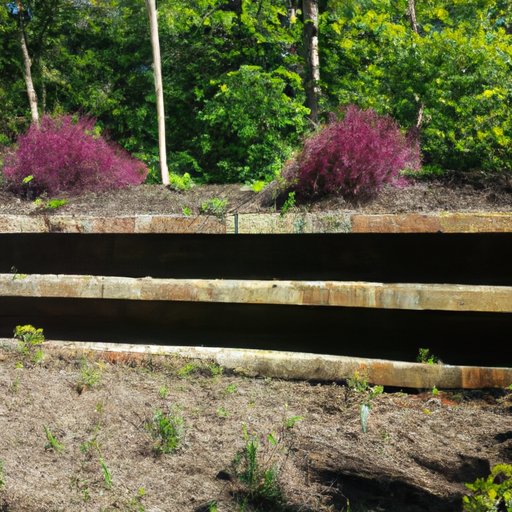
Introduction
If you’re looking to improve the look and function of your outdoor space, building a retaining wall can be a great project. Not only does it add visual interest and structure, but it can also help control erosion and add valuable space for gardening or recreation. In this article, we’ll walk you through the steps needed to build your own retaining wall, from materials and tools to overcoming common challenges. Plus, we’ll offer inspiration and troubleshooting tips to keep your project on track.
Step-by-Step Guide
Building a retaining wall can seem like a daunting task, but by breaking it down into clear steps, the process becomes much more manageable. Here’s an overview of what you’ll need to do:
- Determine the height and length of your wall
- Excavate the area where the wall will be installed
- Install the base material, such as gravel or crushed stone, to provide a stable foundation
- Lay out the first level of blocks or stones, ensuring they are level and secure
- Continue building up the wall, checking for level and stability at each level
- Backfill behind the wall to create a stable slope
- Finish the top of the wall with caps or stones
Of course, each of these steps requires more detail and nuance, so let’s dive in.
Materials and Tools
Before you get started, it’s important to have the right tools and materials on hand. Here are some of the key items you’ll need:
- Blocks or stones for the wall (check with your local hardware or outdoor store for options)
- Base material, such as gravel or crushed stone, for the foundation
- Backfill material, such as garden soil or topsoil
- Masonry adhesive for securing the blocks or stones in place
- Level and tape measure for ensuring accurate construction
- Shovel and wheelbarrow for moving materials
- Safety equipment, such as gloves and protective eyewear, for handling materials
It’s worth noting that the exact materials and tools you need will depend on the size and design of your wall, as well as any slope or drainage issues that need to be addressed. To ensure you have everything you need, consult a professional or check with an outdoor store that specializes in retaining wall materials.
Overcoming Challenges
One of the biggest challenges when building a retaining wall is addressing issues related to slope, soil quality, and drainage. For example, if you’re dealing with a steep slope, you may need to dig deeper and use more base material to ensure the wall is stable. Alternatively, if your soil quality is poor, you may need to amend it with compost or other organic matter to provide the necessary nutrients for plant growth.
To address these challenges, it’s important to do your research and consult with experts. Many outdoor stores and hardware stores offer tips and advice for overcoming common problems. Additionally, online resources such as gardening forums or DIY blogs can be a great source of inspiration and troubleshooting advice.
Inspirational Examples
One of the best ways to get inspired for your own retaining wall project is to see what others have done. There are a wide variety of stunning and creative retaining wall designs out there, from natural stone to colorful brick to modern concrete. Here are a few examples to get your creative juices flowing:
- A natural stone wall built into a garden bed, with cascading plants spilling over the edges
- A curved brick wall that doubles as seating for an outdoor gathering area
- A modern concrete wall with built-in planters and water features
- A tiered retaining wall system that creates multiple levels of planting space
Of course, these designs may be more complex than what a beginner might tackle, but they offer valuable inspiration and ideas. To adapt these ideas to your own space, consider the materials and style that best match your landscape and needs.
Troubleshooting
Even with the best planning and preparation, issues can arise during the construction process. Common problems include blocks or stones that shift out of place, areas where the wall doesn’t feel level or stable, or unexpected changes in the slope or soil quality that require adjustments to the wall design.
To address these issues, it’s important to stay patient and flexible. Take breaks as needed to avoid making mistakes due to frustration or fatigue, and consult resources such as online forums or professional contractors if you need additional guidance. Additionally, consider making adjustments to the wall design or layout to address unexpected changes in slope or drainage. By staying adaptable and open-minded, you can overcome even the toughest challenges in retaining wall construction.
Benefits of Retaining Walls
Building a retaining wall is not only a beautiful addition to your outdoor space, it also offers a host of practical benefits, such as:
- Stabilizing slopes and preventing soil erosion
- Creating usable space for gardening or recreation
- Adding visual interest and structure to your landscape
- Providing an opportunity for creative and personal expression
Whether you’re focused on the practical or aesthetic benefits of retaining walls, there are plenty of reasons to consider this project for your own space. By following the steps and advice outlined in this article, you’ll be well on your way to creating a beautiful and functional retaining wall of your own.
Conclusion
Building a retaining wall can be a fun and rewarding project for anyone looking to improve their outdoor space. By following the step-by-step guide, gathering the right materials and tools, and staying flexible and resilient in the face of obstacles, you’ll be able to create a beautiful and functional retaining wall that will enhance your landscape for years to come.




